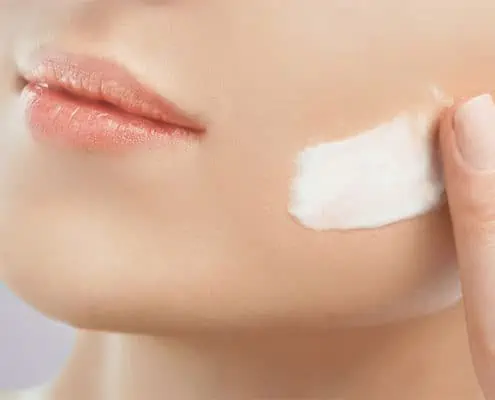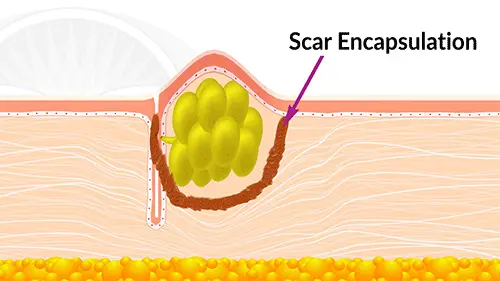

Acne : What is it? What Causes it? The Basic Science
Basic Scientific Background of Acne Explained:
For those who desire a basic scientific background on acne, the following series of articles will bring you up to speed with scientific accuracy but with the ease of common language and metaphor. Effective treatments for acne are discussed in earlier articles in this series.
There are 4 main “players” involved in the development of acne.
Acne occurs inside hair follicles, which appear as pores at the surface of your skin, and which may also grow hair. (The vast majority of your hair follicles do not grow hair even though they are capable)
Follicles contain tiny sebaceous glands that produce the oils (sebum) needed for skin to be healthy. The sebum is secreted out of the pore onto the surface of the skin where it is absorbed into the most superficial layer of the skin called the “Stratum Corneum”.
The Stratum Corneum is the uppermost and dead layer of your epithelium, which forms a protective crust that surrounds our bodies. Once filled with oily sebum, this protective crust also serves as a critically important moisture barrier that keeps you from drying out (desiccation).
As we age this dead layer of our epithelium gets thicker and “dulls” our skin. To compensate for this dulling, many women routinely exfoliate this dead layer of skin in order to brighten their faces.

When sebaceous glands become overactive, they grow too many sebum producing cells which produce too much sebum (oil). The excess number of sebum producing cells causes large numbers of these cells to die and slough off (shed) which can block or clog the follicles deep in their associated pores.
Notice how it is gunk from the inside, not dirt from the outside that causes acne. Although keeping your skin clean is important and does help, it won’t get rid of acne.
In overactive glands cellular turn-over is highly accelerated causing the production of an excessive amount of dying cells that need to be removed or “cleaned up” by the body’s physiological cleansing systems. If the amount of dead cells overwhelms the “clean up” capacity of the gland, clogging and congestion can occur producing a variety of disease states such as acne.
All tissues are designed with a normal turn-over of cells, whereby the tissue generates new cells to replace older, tired and dying cells. This also means that all your cells are programed to die at a particular time (apoptosis).
When you were young your various tissues and organs were replacing themselves much quicker than when older. That is why most diseases are associated with aging. Simply stated; with age cellular turnover is slowing down and our cells are getting older before being replaced. Consequently their ability to perform their necessary physiological functions degrades to the point where they become more susceptible to dysfunction and disease.
In healthy skin, oil (sebum) is secreted out of the pores to coat and protect the surface of our skin. However, a clogged pore that cannot release its sebum will become swollen with excess dead cells and sebum. (Like a swollen distended balloon that is over-filled and could burst) This is the off-white puss-like substance that fills acne lesions.
To make things worse, bursting follicles create an opportunity for bacteria to colonize the vulnerable ruptured follicle which causes an infection and makes the acne much worse.
The “gunk” that you may squeeze out of your acne that looks like infected puss typically is not. The white gunk is the over-produced, dead sebaceous gland cells that have been shed from the gland and mixed with sebum.
If an infection does occur in the follicle, it is typically after the follicle has ruptured, presenting to bacteria and ideal place to colonize. Warm, protected, filled with blood and nutrients.
In general, stress can boost your chances of having acne. Stress and certain hormones produced when stressed (such as cortisol) are linked to acne, but it is doubtful that stress alone will cause acne.
If, on the other hand, you already have acne, stress can definitely make it worse. The ugly truth is that stress can make any condition you have worse, as well as lower your resistance to becoming ill in the first place.
Sex and masturbation do not cause acne. The myth was started centuries ago probably to scare teens from having sex. (Even the fear of deadly STD’s doesn’t seem to inhibit teen sex… let alone acne!)
Teen hormones and acne are directly linked. Male sex hormones, especially in the teenage years, can cause an increased sex drive. The increased sex drive leads people to believe sex and acne are linked. However, the link is actually between hormones and sex drive rather than the actual sexual activity.
There is currently not enough research on how diet affects the onset of acne. However, experts do know that acne is dramatically higher in western society where certain foods are eaten in much larger quantities. These foods are categorized into three groups: Refined cane sugar, cow dairy and refined wheat flower or glutens.
Indigenous native societies consume hunter and gatherer diets that contain very little of these three food types, and experience far less acne. Experts are unsure whether this is a result purely of diet or has a genetic component. Patients should be aware of these dietary correlations, and test themselves to verify if eliminating these foods does in fact make their acne better.
In the early stages of developing acne, blackheads and whiteheads called comedones, appear as little swollen acne bumps. Once formed, acne will progress into one of two types of acne:
Non-inflammatory types of acne occur when whitehead and blackhead pimples called comedones, have not become inflamed. Non-inflammatory types of acne can be healed by releasing the oil (sebum) at the surface commonly known as extraction.
However, if the follicle wall ruptures (like an overfilled water balloon) sebum will leak into the surrounding tissue, causing irritation and stimulating an inflammatory immune response which makes the acne much worse. A ruptured follicle either occurs naturally when so swollen with accumulated sebum and dead cells it ruptures on its own, or by manual popping or squeezing acne blemishes.
Thus your mom was right, don’t pick, squeeze or pop your acne!
Whiteheads occur when sebum is caught below the surface of the skin in a blocked follicle. The blockage is often caused by an over-thick Stratum Corneum. The sebum pushes up and creates an acne bump with a white pointed tip. When extracted white sebum the consistency of lotion is pushed out of the follicle.
Blackheads occur when pores are not obstructed and sebum rises all the way to the surface. At the surface, contact with the air causes the sebum to oxidize (like a banana that turns brown when exposed to the air) which turns it into a black or brown color and thickens it into a more waxy substance. When extracted, it often exits the pore as a long continuous thread-like piece of waxy sebum that is black (oxidized) at the surface and white deeper in.
Inflammatory types of acne form when the swollen mass of blocked sebum and dead sebaceous gland cells distend the walls of the follicle to the breaking point. This is called an acne pustule which is like a swollen water balloon that is about to rupture.
The distended follicle causes considerable irritation, which is further exacerbated when the wall of the follicle finally does rupture releasing the contents to the surrounding tissue. The body reacts with an inflammatory immune response including a flood of white blood cells that result in an inflamed acne lesion. Now the white “gunk” that comes out of a swollen acne lesion is a combination of sebum, dead sebaceous cells and immune system white cells.
If the acne lesion becomes infected with bacteria, bacteria will be added to the mixture. (Not very appetizing, is it?)
In some cases, sebaceous glands, in addition to becoming hyperactive also become hugely overgrown, or hypertrophic. They can become hundreds of times their normal size, producing swollen enlarged acne bumps that feel like hard pea sized nodules under the skin. They are filled with dead sebaceous cells and the sebum that these cells produced
The cute little sebaceous gland has grown out-of-control and becomes a monster sebaceous cyst. As they enlarge they displace all the tissue that normally surrounds follicles in the dermis and epidermis, which is an enormous irritation to the skin. An inflammatory immune response quickly follows, as the body is alarmed by the growth of a foreign body in the skin.


Note: As the cyst expands within the dermis of a patient’s skin, it displaces the collagen matrix like a bubble or balloon. In reaction to this, the inflammatory immune response can be intense, and if the cysts persists for long enough the inflammation can cause the formation of scar tissue. When the cysts finally dries up, the scarring around the bubble remains resulting in the unfortunate pitting commonly seen with severe cystic acne.
In severe cases, cysts might expand into each other and merge into a single enormous lesion that must be lanced, drained, irrigated, cleaned and closed (sometimes with sutures). Cysts such as these can be very painful and often leave severe scarring. Cortisone injections are also commonly used to arrest the inflammatory process. However, cortisone also inhibits the formation of collagen, and therefore might contribute to worse pitting if used to often.

Tiny white bumps the size of sesame seeds called Milia are often confused with acne. Milia are not a type of acne. Milia are tiny cysts filled with keratin that can form in superficial layers of our skin. Keratin is a hard protein filament that epithelial cells in our skin make in order to provide protection to our bodies. Hair and nails are made of keratin.
Milia are most commonly seen on the nose and cheeks of newborn babies who rarely get acne. However, adults can have Milia. Why anyone gets Milia is unknown. Typically Milia will diminish once the skin naturally peels off (exfoliates). Unlike acne which can persist for long periods of time, it is rare for Milia to last a long time. Removing Milia is much simpler than healing acne and can be easily and effectively treated with extractions performed by a qualified medical aesthetician.
Doctors Alice Pien, MD and Asher Milgrom, Phd are established pioneers in the fields of Regenerative Medicine and Skincare. Their expertise ranges from advanced laser systems to HCT/P – Stem Cell medicine. Their medical education and advanced certifications span from medical schools of NY State University, the University of Chicago, to Johns Hopkins, Harvard and UCLA. They approach medicine with the clinical expertise of over 85,000 successful treatments over the past 20 years and significant scientific research resulting in proprietary protocols that they customize for each individual patient.
AMA Regenerative Medicine & Skincare | 1570 Brookhollow Dr., Santa Ana, CA 92705 | 6310 San Vicente Blvd STE 285, Los Angeles, CA, 90048 | Privacy Policy